Pratt Hobbies D-Region Tomahawk (18mm)
Pratt Hobbies - D-Region Tomahawk (18mm)
Contributed by Josh Joung
| Construction Rating: | starstarstarstarstar |
| Flight Rating: | starstarstarstarstar_border |
| Overall Rating: | starstarstarstarstar |
| Manufacturer: | Pratt Hobbies  |
Brief: Construction:
A simple, cheap, and relatively good looking kit for beginners.
The kit came with:
-
1 Nose cone
-
1 Nose cone shoulder
-
1 Body tube
-
4 Precut balsa fins
-
1 Long Kevlar shock cord
-
1 Nomex protector
-
1 Streamer
-
1 Motor block
-
1 Launch lug
-
1 Sheet of decals
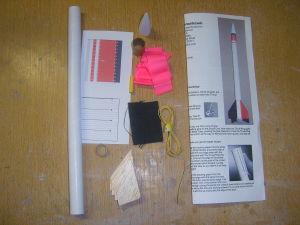
First off, start by attaching the shock cord to the motor block with a knot. I deviated a bit from this step and cut out a small notch into the outside of the motor block for the shock cord to rest into. Without the notch, the Kevlar would make it a very tight fit and the place where the shock cord was tied would show up as a bulge in the body tube. Then, test fit and glue the motor block into the body tube. Insertion of the motor block is via a spent motor case. The motor should have about 1/4" of overhang. Next, cut out the fin wrap and apply it to the bottom half of the body tube. The directions state to align one side of it with the pencil line drawn down the body tube (the directions make it seem that the body tube was supposed to come with the line; well this one didn't, but the line was quickly drawn with the help of a door jam) and gradually apply it around the entire body tube. After applying the fin alignment wrap, cut out the payload section decal and apply it to the top of the body tube, using the same method that the fin wraps used. Next, apply the fins with white glue. The fin wraps have lines running vertically down serving as fin guides, making it more builder-friendly, especially to the beginner. I noticed that the fins were ridiculously thick, compared to the size of the rocket. They were 1/8", but I found out that the thickness helped more precise alignment of the fins, once again making it more builder-friendly. Instead of using white glue to apply the fins, I used CA. Then, the instructions have you move onto the nose cone, but I went ahead and filleted the fins first so I have something to do while they dry. But before the fillets, I decided to toughen up the fins by soaking them with CA. I usually use wood glue for all my fillets, including mid power builds, but I went with the instructions and used white glue, probably for clear fillets as this rocket doesn't need any finishing besides decals. While the fillets are wet, press the launch lug into one of the fillets and let it dry. Now for the nose cone: something I really didn't like about it was that it is absurdly thin. It can be easily crushed or torn with little force. Test fit and glue the nose cone shoulder into the nose cone, with about half of it inside the nose cone, making sure the hole on one end of the shoulder (used for shock cord attachment) is on the outside. I could only get the shoulder about 1/4 to 1/3 of the way in the nose cone without deforming it. Thread the shock cord through the Nomex cloth, streamer, and then the hole in the nose cone shoulder, in that order. Tie the shock cord onto the hole for a secure fit. With this set up, the nose cone had a very tight fit, so I pressed the area of the shoulder where the shock cord was attached in, forming a shape that resembles Pac Man.
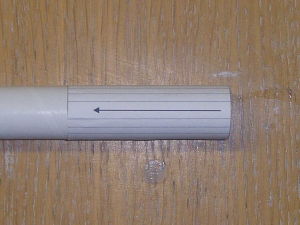
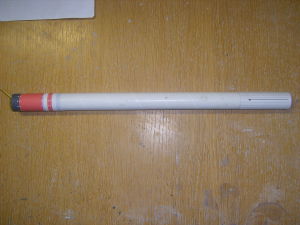
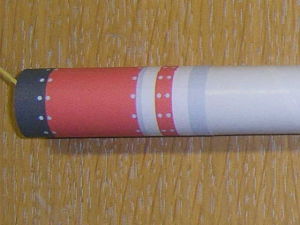
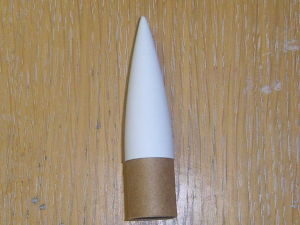
PROs: The kit is easy to build with minimal supplies and most of the components or of high quality.
CONs: The nose cone can be of higher quality.
Finishing:
The fins can be colored in with a marker, one fin colored red and the others black, but I decided against it. I thought the rocket looked fine the way it was, and I was probably going to lose it any way. Besides coloring the fins, the decals supplied were the only other form of finishing, but they were applied in the beginning of the build, unlike most rockets.
PROs: Very simple, fast, and easy to finish.
CONs: May be a bit too simplistic, although for the more experience people, more time can be put into finished for a better and higher quality finish.
Construction Rating: 5 out of 5
Flight:
Preperation for flight is very simple. Lay the heat protector over the body tube and push it into the tube. Fold up the streamer and push that into the tube as well, along with the shock cord. Put the nose cone on and install the motor, and it's ready to fly. I liked the fact that the kit came with the Nomex®, even though it's such a small kit. The first flight used an A3-4T, using a Quest motor case with the nozzle drilled out and the crud cleaned out as an adapter. It went very high, considering the motor, in a short amount of time. It reached apogee at about 450 feet and the streamer popped out. It came down about 250 feet from the pad. The second flight was with a B6-4, and I made it a tighter fit than the previous flight. I also replaced the supplied streamer with a fluorescent orange streamer about one inch wide by about five feet long, since it was hard to spot at just 450 feet. It went higher and faster than the previous flight to about 800 feet. When the streamer deployed, it was very easy to see and I was glad that I replaced the streamer. It came down about 200 feet from the pad.
PROs: Flight prep is very fast and it is a blast to fly, despite its small size.
CONs: None.
Recovery:
On the first flight, the rocket came down relatively fast and landed on the air strip (as I was launching from an abandoned air base). One fin was slightly damaged, but it wasn't bad enough that I had to repair it. A little sanding to get it smooth did the trick when I got back home. The motor and the adapter also kicked upon ejection. On the second flight with the longer streamer, it came down slightly slower than the previous flight, and I was satisfied. The motor also did not kick as I had made it fit tighter than before. Its third flight was in my backyard. I used an A10 and taped 0.5 oz of fishing weights to the shock cord to weight down the rocket for a lower flight. The streamer melted together at the end, but the Nomex probably didn't work because I didn't repack the laundry before launch--it was packed up in the rocket for about a month. The only bad part is that it's a bit difficult to fold up the five foot long streamer in the wind.
PROs: The Kevlar shock cord and Nomex heat protector, both supplied in the kit, worked perfectly and help to lower the require maintenance, which isn't really necessary in the first place.
CONs: None. Any faults during recovery can be traced back to the flier and can be fixed during the next flight (the motor can be made to fit tighter, for example).
Flight Rating: 4 out of 5
Summary:
This one will see a lot of flights in the future. I don't really enjoy the zip-gone type of flights, but this rocket is really fun to fly. It's very easy and quick to build, as well as prep for flight.
PROs: A very easy kit for beginners and is fun for all hobbyists.
CONs: None.
Overall Rating: 5 out of 5
 |
 |
Flights
 |
 |